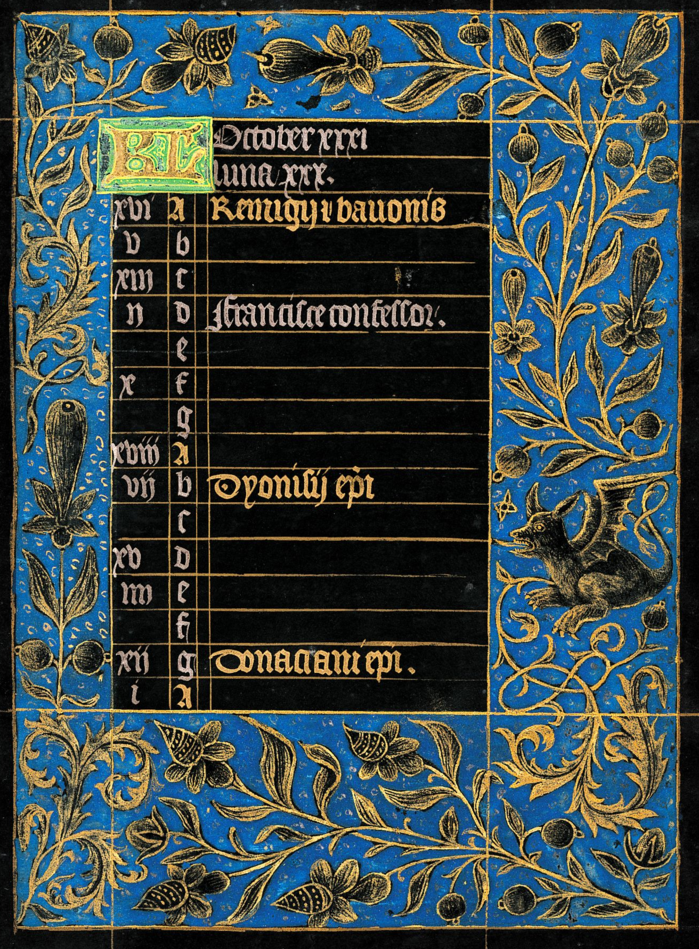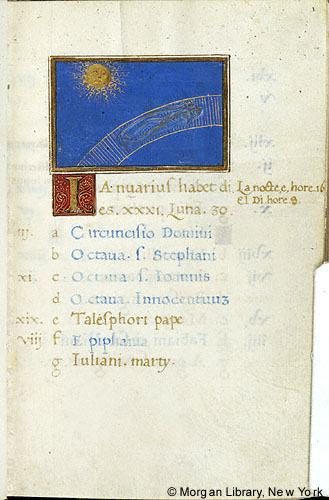A quick summary of several Books of Hours added from my most recent trip to the Morgan Library in New York.
- M.141 - A late 14th C Parisian book, with a simple red/black complete calendar. There are errors in the listings, but no more than the usual number. The later months have multiple unidentified saints, including a saint “Olati” for Dec. 10 and Saint “Dani” on Dec. 5. (DB Id: 234)
- M.729 - The Hours of Yolande de Soissons, this is a Psalter/Hours, but has been added due to the unusually specific location, Amiens, and the rather precise date, 1280-1299, for such an early book. The Calendar has some specific-to-Amiens feasts, such as the Octave of St. Firminus, October 2. It’s triple graded as well, with blue for high importance and red for more medium-weight saints, though that is not a definite interpretation. (DB Id: 77)
- M.739 - This is a particularly old hours, 1204-1219, and from Moravia, which is a rare location. The calendar is damaged for the month of January, with the last 10 entries very difficult to read. There is also evidence of multiple generations of writing and rewriting, including additional saints and obituaries. Five entries for November were erased and rewritten, and it is unknown if these were changed. Of the saints from the original strata there are many unusual ones, such as St. Columba, along with the usual Pope Silvester, on December 31. Multiple saints are not yet identified. (DB Id: 175)
- M.1054 - A nice late 15th C book of hours from Tours, decorated, according to the catalogue by a “Distant follower of Jean Bourdichon”. The calender has a fantastic architectural border on the rectos, with the zodiac and the labors integrated into the frame. Interestingly the calendar is unevenly split, with about 20-22 entries on the recto and only a few on the versos. It is almost complete, but several months have a missing name for the last of the month. (DB Id: 228)
- S.9 - A Parisian book, illustrated by two associates of the Luçon master. The calendar is error-filled, both containing many saints on the wrong date as well as having many of the initials incorrectly filled in as ‘S’, such as “Sostre Dame” for Nostre Dame and “Ses Innocens” for Les Innocens. (DB Id: 226)
Note that with these additions, the total number of entries in the DB is 48910, 31951 of those have at least one saint.
After another 2 day visit to the Morgan Library, I am once again bulk-loading data. The first three books from this trip are:
- M.487 - An English MS from the 1490s, probably made for a small child as there are many more educational texts than usual. Saints are quite British, including David, Cedde, Richard and Cuthbert. Unusually St. Edward, King, on March 18 is in red. (DB Id: 233)
- M.116 - A French MS from Cambrai, made in the 1490s. It contains a fair selection of feasts unique to Cambrai, including Translation of St. Barbara on Feb 12, St. Waltrude on April 9 and St. Salvius (in red) on June 26th. It also contains both the feast, on August 11, and the Octave, on August 18 of St. Gaugericus of Cambrai. (DB Id: 229)
- M.1089 - An Italian MS, probably made in the Veneto around 1425-1450. The calendar is misbound, ff. 6-7 are first, then ff. 1-5 and 10-14, no folios are numbered 8-9. The calendar is sparsely populated, only 116 entries, and very red, more than 50% of the entries. There are a few entries that might indicate a Fransiscan influence and one unusual one, St. Daniel the Prophet listed on July 24, though his feast is July 21. This is unique, so far, in the corpus. (DB Id: 106)
Back to the Morgan Library for M.493, the Morgan Black Hours, so called because they are written in silver and gold in on black-stained parchment. The bad news is that this treatment makes the illumination, particularly the colors, very fragile and prone to flake off. The good news is that means this is one of the few books at the Morgan that has been fully digitized. As is common, the style of the illumination seems to derive from the work of Willem Vrelent.
The calendar is sparse, with only 111 entries across the span of the year, nearly 1/2 of those (52) in gold for high importance. With that few entries it is harder to draw any conclusions from the calendar, but Bishop Donatiani (of Reims) (See October f.11r below) appears in gold, which seems unique to Flemish manuscripts.
(DB Id: 218)

Down to the last* of the major set of Morgan Library books, M.99 is a very British book of hours, made at St. Peters, Gloucester around 1405-1415. Though trimmed and rebound the current size, about 8"x6", suggests originially it was quite a large book compared to many Books of Hours. The calendar contains, apart from the usual English saints, Oswald, Cedde, David, etc, multiple obituaries for local ecclestiacs and even the dedication of St. Peters, September 18th. As usual with British calendars, many of the 'pape' inscriptions have been erased, though Thomas Becket was untouched. There's an unusual error in the date information for December, after the Ides, the countdown to the Kalends starts at 18, rather than the accurate 19. This was caught somewhere during the work and, though not fixed, the line for III before the KL was duplicated, so at least there are the right number of entries.
(DB Id: 80)
* 2 Morgan MS remain, both are waiting on some additional information from the imaging department to be entered into the DB.
Morgan Library M.361 is one more of the Italian books of hours, this one from Florence. The calendar is sparse, perhaps the least populated calendar I've seen so far, with only 118 entries. The entries are a perfect case study for localizing a calendar though. Most of the entries are the extremely common ones, Apostles, life of Mary, Jesus and John the Baptist, etc. There are 3 hapex saints, however, in early summer:
- May 25 - St. Zenobius, bishop
- June 6 - St. Alexandrus, bishop
- July 6 - St. Romulus, bishop and martyr
Of these the first is localized to Florence (Zenobius is regarded as the first bishop of Florence) and the other two to Fiesole, 5 miles from Florence proper.
(DB Id: 171)
We've not yet run out of Italian books from the Morgan Library. M.305 is localized to Florence, dated circa 1495. The calendar is nearly complete, containing 340 entries and all 12 zodiac entries, so only 12 empty lines. It also has a unique color scheme: red for normal, blue for high rank feasts and gold only for vigils (all vigils are gold) and the Zodiacs. The last 2 entries in September (Michael the Archangel and Jerome) are unusual, they're red, but with a gold initial. There's a manicule pointing to Michael, perhaps an indication of one of the previous owners. The calendar is filled with errors
- Several days were omitted in the sequence and their dominical letter/golden number added in the margin
- The first letter of every month was never written in, there's a gap between the KL and the rest of the word, but no initial (i.e. KL ept[m]ber at the start of September)
- The last four saints in January were written one line off, with scribal correction
Finally there are many unidentified saints, but it is unclear if these are in error or too specific in localization to be recorded in the more general reference materials. The hand is a lovely Humanist, with regular capitolization and mostly regular gendering of titles (Sce vs Sci vs Scor[um]).
(DB Id: 170)
An interesting postscript, this MS was rebound in the early 20th century by Marguerite Duprez Lahey in a lovely, if overly tight, light brown Morocco. There's an outer case in 1/2 leather, 1/2 marbled paper. The later matches the end-papers
Morgan Library M.56 is a tiny northern Italian Book from the second half of the 15th century. The hours are illuminated in the somewhat florid late Italian Gothic, but the calendar is quite plain, with just a simple blue KL at the start of each month. The saints represent the usual ones, with some specifically Italian additions. There are also two oddities, both the entry for Feb 25 (St. Constantine) and for May 13 (Pope Theodore) list them as Virgins, rather than bishops or popes. It is possible that other saints are meant, but I was unable to find a reference anywhere to a female saint on either date. Interestingly M.14 (DB Id: 164) also includes Pope Theodore, listed as a Virgin.
(DB Id: 109)
Morgan Library M.187 is c.1480 book from Ferrara. It's written in a lovely Gothic rotunda hand, with some light foliate decorations around the calendar pages. The calendar itself is unlocalized, but tends towards Fransiscan feasts, including the reception of the Stigmata and the Translation of St. Clare in gold. The rest of the calendar is Northern Italian and very accurate, with only a handful of unidentified or incorrectly dated saints.
(DB Id: 166)
Morgan Library M.14 is another Italian Book of Hours, this one is from the 1490s, from Florence and was owned by the Franceschi-Pitti family, their arms are in it. The calendar is very unusual, in layout, in decoration and in population. Each month has 3 sides, with an illustration of the sign of the Zodiac in the sky at the start (see f.1r below). The short Egyptian verses are in the outer margin, in a smaller hand, and there is no KL for Kalends, only the first letter of the month in gold on a jewel-tone background. The feasts are graded in gold and blue, with blue the most important ones. The saints are a mishmash of unusual Italian and French saints, many of them heretofore unrepresented in the DB. With a few minor exceptions, a wrap-around error on King Sigismund (listed on April 30) being the most obvious, the saints are accurate. There are 2 missing days in the calendar, July 1 and November 12, but the scribe managed to catch Nov. 12 and inserted at least the dominical 'a' interlinearly in blue. No indication exists that the missing July 1 was noticed.
(DB Id: 164)

Morgan Library M.92 is another Book of Hours from my recent trip. This one is a very early, 2nd quarter of the 13th century, French book, probably made in Paris but use of Soisson. The first couple of leaves are full-page miniatures of the life of Mary, though only as it pertains to Jesus. They start with the Annunciation and proceed through the scenes of Jesus' first year and then Crucifixion. The last few are the death and accumption of Mary, and these are followed by the calendar, starting on f.15r. This calendar is quite lovely, with rondels for both the labor and the zodiac on the outer margin, and bright gold for the parts of the Roman month (Kalends, Nones, etc)
The calendar is interesting from a scribal-practice sense, as the Lombard capitols, in red and blue, that go with most of the Saints were clearly done by a second scribe. These are wrong quite often, and in ways that are so nonsensical, which is entirely different from the very careful and accurate main scribe. Not all the errors are even on unusual saints, December 25th is "Sativitas d[omi]ni n[ost]ri ih[es]u [christi] in bethle[hem]e" (see f.20v below. The tiny picture is the only one available from the Morgan). The formation of the text in unusual, many more feasts are marked "passio" than one usually finds
(DB ID: 73)



